
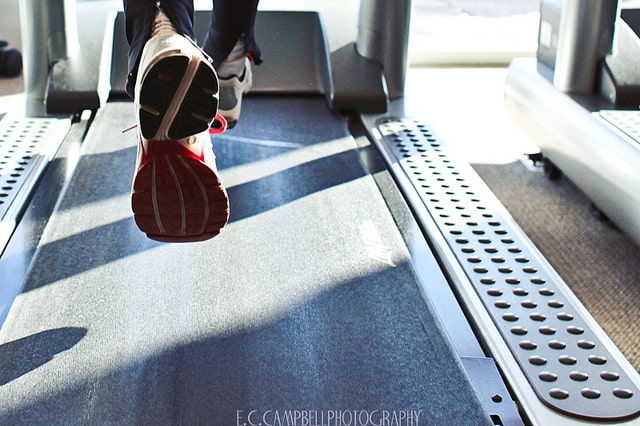
High intensity circuits, high intensity interval training (HIT) and fasted cardio are all popular calorie burning methods.
But which strategy is best for you?
HIIT
If you look at any fitness intensity chart from the 80’s and 90’s, you’ll see a zone referred to as the fat loss zone, which corresponds to roughly 60% of your max heart rate. Trainees were encouraged to workout in this zone because it was thought that fat would be primarily burned for fuel and therefore, reduce overall bodyfat. Then in the 2000s, along came HIIT and EPOC (excess post-exercise oxygen consumption). HIIT involves alternating bouts of high- and low-intensity exercise, designed to increase the total amount of high-intensity work performed during one training session (Schoenfeld & Dawes, 2009) and EPOC refers to the calorie expenditure required for recovery, post workout. A HIIT protocol performed with cardiovascular exercise can include hard sprints followed by easy jogging while a HIIT protocol using weights can include sets of a barbell complex performed with short rest periods between sets.
Research has shown that fat-burning zone-type cardio pales in comparison to HIIT when it comes to maximizing fat loss, as total caloric expenditure and fat breakdown are greater in an HIIT protocol (Schoenfeld & Dawes, 2009). Because of the high-intensity of HIIT, your homeostasis is taken further from its equilibrium compared to a similar session at a lower intensity. Therefore, in addition to burning more calories during the training session, your body will continue to expend calories post-workout (via the EPOC phenomenon) until your body reaches homeostatic equilibrium. This is commonly referred to as a metabolic disturbance; hence, HIIT also being referred to as metabolic disturbance training.
Fasted Cardio
Fasted cardio involves performing cardiovascular exercise, at a high- or low-intensity, on an empty stomach. The theory and belief behind this method of training is that the body will utilize fat as the main energy source, instead of carbohydrates, therefore resulting in greater fat loss (Schoenfeld, 2011).
According to Brad Schoenfeld, MS, CSCS (New York), a lecturer in exercise science and author of the Max Muscle Plan, this form of training “confers any fat loss benefits over and above non-fasted cardio” and that science does not support its efficacy (Schoenfeld, 2011). Tony Gentilcore, CSCS (Hudson, MA), strength coach and co-founder of Cressey Performance, says the “substrate you’re burning doesn’t really matter during [the actual training session.]”
If you have more fuel in your system, you should be able to train at a higher intensity and hypothetically burn more total calories overall, states Gentilcore. Eating a pre-workout meal is actually associated with a greater number of expended calories both during and after the workout and therefore enhances fat loss, compared to working out in a fasted state (Schoenfeld, 2011). There are several factors that influence fat mobilization and usage from subcutaneous adipose tissue says Schoenfeld. “It is shortsighted to look solely at how much fat is burned during an exercise session,” he states as “the human body is very dynamic and continually adjusts its use of fat for fuel.” Schoenfeld (2011) adds, “if you burn more carbohydrates during a workout, you inevitably burn more fat in the post-exercise period and vice versa.” Therefore, training fasted or fed does not directly influence your ability to burn fat for fuel.
According to Schoenfeld, the “bottom line is that in trained individuals, there does not seem to be any advantage to fasted cardio from a fat loss standpoint.” In addition, training with depleted glycogen levels (carbohydrate stores) has been shown in the research to increase protein breakdown, a process with detrimental effects for trainees concerned with building muscle and strength (Schoenfeld, 2011).
Fat Loss Folly: More Is Not Better
Gentilcore cautions trainees from taking their conditioning too far because “there comes a rate of diminishing returns [when thinking] more is better.” Protein synthesis and muscle building may be sacrificed if too much HIIT and cardiovascular exercise is added to a training program, says Gentilcore. Schoenfeld agrees stating that combining high training volumes with high intensity workouts of both weightlifting-type and aerobic-type exercise can result in overtraining and “impair protein accretion as well as [have] negative effects systemically on the body, that impairs results.” Stop worrying about burning fat on an hour-to-hour basis and instead consider it over the course of several days to see how it impacts your body composition (Hansen et al., 2005).
Putting it Into Action
Adding muscle to your frame takes a dedicated bodybuilding program complimented with a healthy nutritional plan with a slight calorie surplus. Depending on this surplus, additional calories may be stored as fat, taking away from the appearance of shredded striated muscles. When adding fat loss workouts to your program, focus on these tips:
If your goal is purely hypertrophy, focus on your bodybuilding program and add in low-intensity cardio as a separate training session if you think it’s necessary. Depending on your recovery ability, you can add 2-4 low-intensity aerobic sessions per week. An example session may involve an incline treadmill walk for 30-60-minutes as 60-65% of your max heart rate. Going for a walk around your neighborhood is also a great alternative. This form of training will not take too much out of you, unlike HIIT; therefore, saving energy for your muscle building workouts.
If your goal is purely fat loss, incorporate these training sessions in the fed-state:
2-3 sessions/week of HIIT with weights (e.g. barbell complexes, resistance training circuits, sled pushes, kettlebell swings, etc.)
1-2 sessions/week of HIIT performing sprints (e.g. hill, track, spin bike, etc.)
1-2 sessions/week of low-intensity cardio
Just as with the hypertrophy protocol, pay attention to your body and recovery ability before adding more training sessions to your program.
References
Hansen, K., Shriver, T., & Schoenfeld, D. (2005). The effects of exercise on the storage and oxidation of dietary fat. Sports Med, 35, 363-373.
Schoenfeld, B. (2011). Does cardio after an overnight fast maximize fat loss? J of Strength and Cond, 33(1), 23-25.
Schoenfeld, B., & Dawes, J. (2009). High intensity interval training: Applications for general fitness training. J of Strength and Cond, 31(6), 44-46.
This article first appeared on MuscleMag.com
photo credit: eccampbell via photopin cc
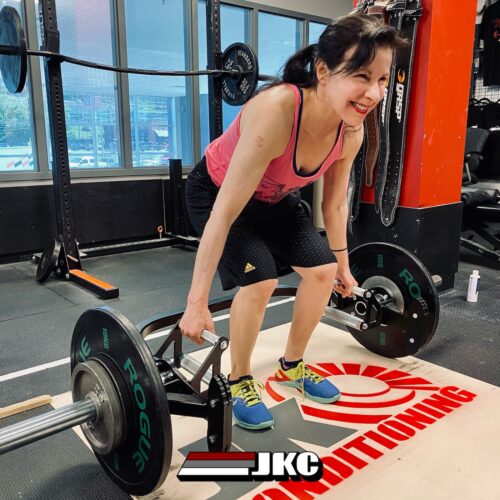
JKC was recommended by a previous trainer who followed Jon online. He thought Jon’s approach to training was excellent. JKC employs well educated trainers who are very particular about technique and form. I have never injured myself because the trainers know what they are doing. They can always answer any questions I ask about my training. As well the trainers are friendly contributing to a relaxed and friendly atmosphere at the gym.
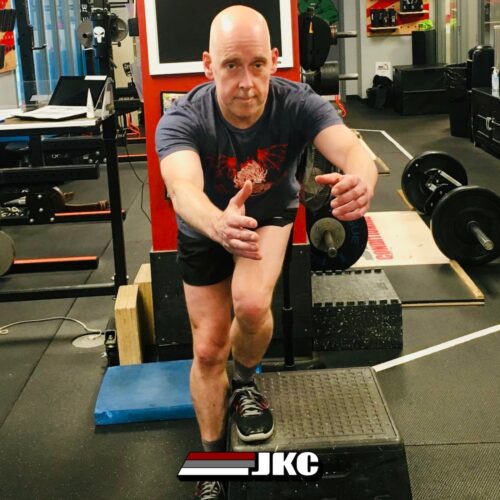
My original reason for joining JKC was to get some sage advice to help with my running. I had been looking for awhile, came across Jon, met for an assessment, and was quite happy with how that all went. Apart from the running specific strengthening and conditioning approaches, JKC is different from other gyms as I am a fan of the small group sessions where everyone has their own goals and individualized programs. As well, the run coaching is super. All the coaches go the extra mile to make sure you get the best out each training session. They are fantastic motivators! My favourite memory is deadlifting 330lbs. Making a lot of great friends and meeting some really cool people is pretty high up on that list, too.
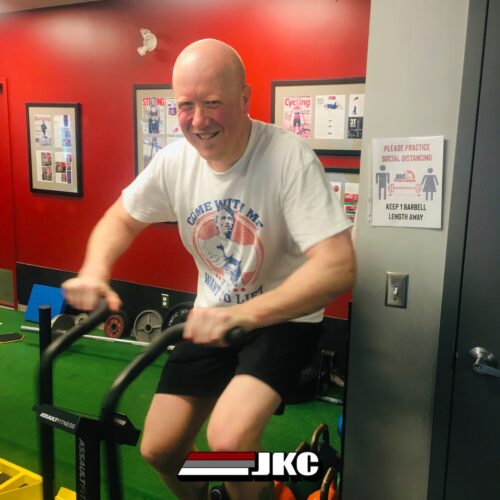
I had spent a fair bit of time in gyms in my teens and twenties but I turned away from the gym to focus on activities that I enjoyed more. What keeps me at JKC is that I do really enjoy it. I always feel that I’ve accomplished something when I leave at the end of my workout. The environment is really positive and focused on challenging yourself whatever your level of comfort and fitness. I’ve also seen results that I’m really happy with; having someone who really knows what they’re talking about to guide your workouts makes them way more effective and focused than just “going to the gym”.
Shortly after I started at JKC, I sustained a fairly major injury that took me off my feet for several months. When I started to get back to activity, it was very difficult. Jon and Thomas worked hard to tailor my workouts to my goals and what I could do. With their help, I’ve been steadily building back strength and function.
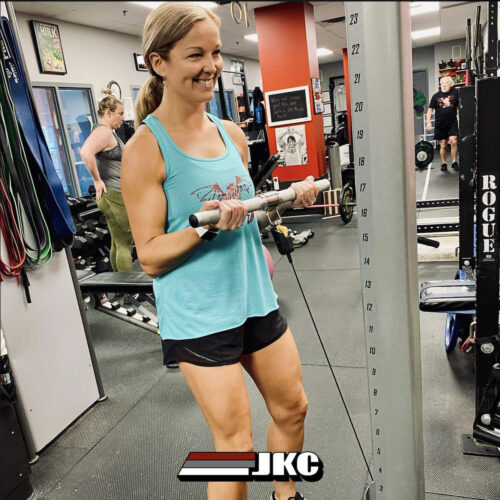
I started at JKC after a good friend recommended it to me. She had been coming for about a year and I was envious of her great results. I felt sluggish after failing to motivate myself with various home workout routines. I love the fun and relaxed atmosphere at JKC. It’s such a comfortable gym space and I enjoy knowing so many of the people I work out with. Jon and Thomas make an effort to introduce everyone to each other and with all the joking around, it starts to feel like a family. Not to mention the awesome results. I’ve always liked to run on a treadmill but I’ve never had the drive to lift weights on my own. Going to JKC makes me accountable which was what I really needed. I feel so much stronger and healthier than I did 4 years ago when I started.
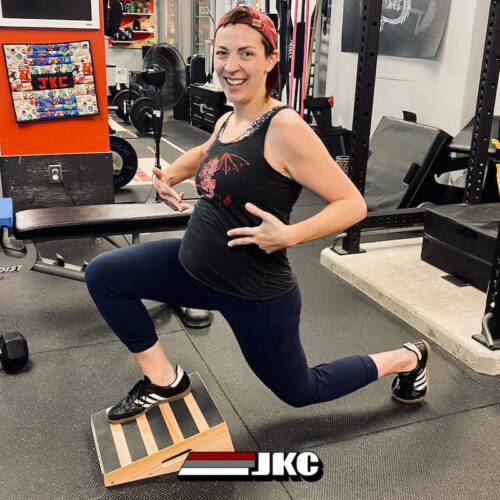
I started training at JKC in 2016 because I’ve always had upper back issues that became aggravated through work. I sought out other training and physio, but experienced little to no results. A client of mine happened to be coming to JKC for a similar issue and highly recommended it. I have had great success and haven’t looked back! I always feel like I’m getting programs tailored to my needs and I’m never bored. I’m 30 weeks pregnant now with my second child and have been able to workout through both pregnancies here at JKC. Even on my least mobile days, I felt safe to workout because my programs were specifically modified for my needs.


































